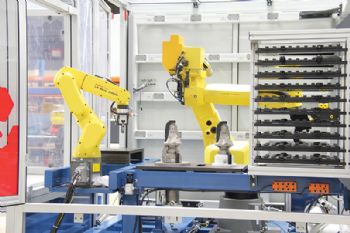
Major aircraft manufacturers predict that the global aircraft fleet will double in the next 20 years; at the same time, regulatory requirements being driven by safety and ecological/ environmental considerations are presenting new challenges for aerospace component suppliers.
Furthermore, the global nature of the aero-space manufacturing industry, combined with the growing complexity of supply chains, means that it is more important than ever to be able to trace individual parts through the manufacturing process — and supply supporting quality assurance documentary evidence.
To help them meet these demands while achieving greater levels of efficiency, manufacturers are increasingly seeking integrated production systems rather than stand-alone machines. Anca (
www.anca.com), a leading manufacturer of universal CNC grinding machines, is delivering new solutions that address these demands.
For instance, by incorporating a robot, Anca’s TXcell grinding cell can automatically load not only workpieces but also grinding-wheel packs, resulting in high levels of efficiency when producing rotary cutting tools.
By incorporating a second robot into a TXcell, Anca can offer machines to undertake applications that require ancillary operations.
Sales of Anca TXcells featuring the two-robot option have been made to a variety of manufacturers, including those involved in the aerospace, medical and specialised-tool industries, where undertaking additional operations in a single set-up brings much greater efficiencies.
In a recent aerospace application, Anca teamed up with other equipment suppliers to deliver a solution for the root-form grinding of jet-engine turbine blades.
Anca’s TX product manager, Duncan Thompson, said: “When performing test grinding with customers, we knew that our TXcell formed an excellent basis for fast and accurate grinding of turbine-blade root forms.
However, in today’s competitive market, we sought to provide greater value to our customers by offering more than the grinding machine itself.”
The first part of the solution worked on by Anca was the automatic part handling of the turbine blades to allow unmanned production.
As turbine blades are non-uniform in shape, they have traditionally been encapsulated in a soft alloy to make them easier to hold during grinding operations.
To avoid this time-consuming process, Anca engineers designed a fixture that holds blades securely — and allows automatic loading.
The loading of blades into the fixture was facilitated by the addition of a second (smaller) robot to the TXcell; the original large robot remains responsible for changing wheel packs and now also for loading the fixture with its blade into the cell.
The use of two robots in the cell presented a wide range of possibilities for other processing tasks — including the addition of part serial numbers for tracking purposes.
This was achieved with the addition of a Cognex camera and an Automator laser etching system to the TXcell. The turbine blade serial numbers are read by the Cognex camera before grinding, and the etching occurs after grinding.
Completing the automation
By adding a Renishaw Equator measuring system to the cell, post process part gauging can also be undertaken. The second robot unloads a finish-ground blade and presents it to the Equator, which compares the part with a traceable master.
The robot returns good parts to the pallet, while failed parts are placed in the appropriate over-size or under-size bin.
Having proved the system’s ability to perform unmanned accurate turbine blade root-form grinding, Anca engineers were tasked with increasing the system’s capacity. They incorporated an automatic pallet change system that extended the system’s capacity from a single pallet to 10 pallets.
In this final configuration, the TXcell was not only grinding the required parts unmanned over a weekend but also adding individual serial numbers that could be validated against a fail-safe quality-control checking system.
In conclusion, Mr Thompson said: “Because of the great success of the dual-robot TXcell turbine-blade application, I anticipate that we will be able to deliver a range of highly efficient solutions that provide cost savings and quality improvements to a range of high-volume component-grinding applications.”